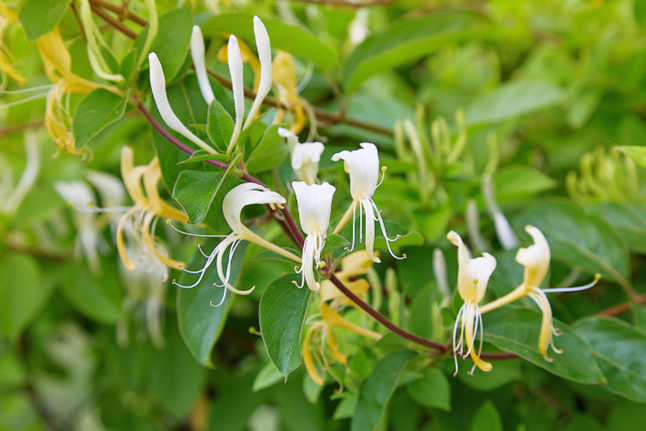By Rachael Leverton
Perfect Partners
When we think about climbing plants, we most often think about growing them to cover a wall or a fence. We might think about growing them over a dead tree stump too, but one of the nicest ways to grow them is through a living tree or a shrub. It’s an excellent way of providing more interest in the same space, either by timing each plant’s display so they follow on from each other, or by timing the flowering so they bloom at the same time, thus doubling the impact of the display. There are a few rules you need to follow when you plant a climber with the intention of growing it up a living host. First, the host shrub or tree should be estab-lished, woody, and strong enough to hold up the climber’s weight when it’s fully grown and flowering. Second you don’t want to use too vigorous a climber, otherwise it might swamp the host. Finally, avoid fast-growing ever-green climbers because they prevent light getting to the host, and may cause it to devel-op disease and die. You can certainly use less aggressive evergreens such as the ivy Hedera ‘pedata’ or Hedera ‘Curlylocks’ around the base of well-established trees. These will look beautiful without overwhelming the structure and flowering of the host plant. Climbers that look good over trees and shrubs are typically, clematis, honeysuckle, and ros-es. Look for species that grow to 3m or less as these are ideal for growing up most garden trees. Species that are cut back to 15-20cm every winter are also ideal. Clematis ‘Abundance’, ‘Etoile Violette’ and ‘Little Nell’ are all good choices. Honeysuckle can often be seen (and smelled) growing through trees in the wild. For your garden look for cultivars of the common hon-eysuckle, such as Lonicera periclymenum. Rambling roses can grow to monstrous pro-portions, so look for smaller varieties such as ‘City of York’ and ‘Parade’, which also have a long season of interest.
If you have a cool moist area try growing the perennial nasturtium, Tropaeolum speciosum. The jewel-coloured flowers will brighten a darker space.
Tips for successful pairing
· Don’t plant the climber too close to the base of the host or they will be competing for the same water and nutrients.
· Counterintuitively plant the climber on the shadier side of the host. That way the climber will be forced to c=grow towards the light.
· If you plant the climber in a large plastic pot with the bottom cut out, it helps contain the plant and reduces competition.
Happy Gardening,

